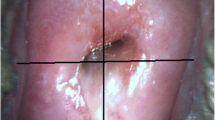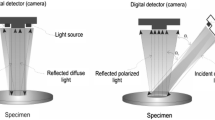Abstract
Purpose
To diagnose early cervical neoplasia cervical by use of in vivo handheld probe based on co-polarized and cross-polarized fluorescence spectroscopy and compare the efficacy with colposcopy and histopathology.
Methods
The cross-sectional observational study was done on 49 patients who came to outpatient department in UISEMH, LLR Hospital between September 2017 to August 2019 with signs and symptoms suspicious of cervical precancerous lesions. Every patient subjected to cervical assessment as well as pelvic examination, cytology and colposcopy followed by evaluation of patient’s cervix was tested in our department by us along with the technical team from Department of Physics, IIT Kanpur, who conceptualized, designed and fabricated the optical handheld probe based on fluorescence spectroscopy. Patients were subjected to colposcopy-directed biopsy, and the sample was sent for histopathological examination in department of Pathology G.S.V.M. Medical college.
Results
The ROC curve for polarized fluorescence spectroscopy peak intensity value with co-polarized light with HPE as gold standard (CIN of any grade or CA as diseased status, otherwise the case is considered normal)) has a sensitivity 100% and specificity 88.9%. The area under the ROC curve (AUC) is 0.916 (95% CI 0.801–0.976) at an intensity of 2134.79 with p value 0.0001. The ROC curve for polarized fluorescence spectroscopy peak intensity value with cross-polarized light has sensitivity 100% and specificity 88.9% with area under the ROC curve being 0.851 (95% CI 0.721–0.937) at an intensity of 2367.54 with p value 0.0001. AUC of 0.8 implies that the technique is a good discriminator. AUC above 0.90 implies that the discriminatory power of the test technique is excellent.
Conclusion
Thus, the in vivo use of optical handheld probe can emerge as a new screening modality thereby detecting precancerous cervical lesions timely and hence early referral to a higher centre for proper and adequate management.



Similar content being viewed by others
References
Arbyn M, Weiderpass E, Bruni L, de Sanjosé S, Saraiya M, Ferlay J, Bray F. Estimates of incidence and mortality of cervical cancer in 2018: a worldwide analysis. Lancet Global Health. 2020;8(2):e191–203.
Jemal A, Bray F, Center MM, Ferlay J, Ward E, Forman D. Global cancer statistics. CA Cancer J Clin. 2011;61(2):69–90.
Bruni L, Albero G, Serrano B, Mena M, Gómez D, Muñoz J, de Sanjosé S. ICO/IARC information centre on HPV and cancer (HPV information centre). Human papillomavirus and related diseases in the world. Summary report, 22; 2019.
Sehgal A, Singh V. Human papillomavirus infection (HPV) & screening strategies for cervical cancer. Indian J Med Res. 2009;130(3):234.
Wright TC Jr. Chapter 10: Cervical cancer screening using visualization techniques. JNCI Monographs. 2003;2003(31):66–71.
Denny L. Cervical cancer: prevention and treatment. Discov Med. 2012;14(75):125–31.
Cronje HS. Screening for cervical cancer in the developing world. Best Pract Res Clin Obstet Gynaecol. 2005;19(4):517–29.
Gupta R, Gupta S, Mehrotra R, Sodhani P. Cervical cancer screening in resource-constrained countries: current status and future directions. Asian Pac J Cancer Prevent. 2017;18(6):1461–7.
Yu B, Ferris DG, Liu Y, Nagarajan VK. Emerging optical techniques for detection of oral, cervical and anal cancer in low-resource settings. Aust J Biomed Eng. 2014;1(2):1007.
Xiao YF, Jiang XF, Yang QF, Wang L, Shi K, Li Y, Gong Q. Tunneling-induced transparency in a chaotic microcavity. Laser Photonics Rev. 2013;7(5):L51–4.
Sokolov K, Follen M, Richards-Kortum R. Optical spectroscopy for detection of neoplasia. Curr Opin Chem Biol. 2002;6(5):651–8.
Drezek RA, Richards-Kortum R, Brewer MA, Feld MS, Pitris C, Ferenczy A, Follen M. Optical imaging of the cervix. Cancer. 2003;98(S9):2015–27.
Mehta G, Pandey K, Pradhan A, Mehta A, Bhagoliwal A, Meena LB, Agarwal A. A comparative study of conventional techniques and hand held probe based on polarized fluorescence spectroscopy in detection of cervical precancerous and cancerous lesions. Int J Sci Res. 2016;5(11):2016.
https://www.nhp.gov.in/disease/reproductive-system/female-gynaecological-diseases-/cervical-cancer.
Parikh S, Brennan P, Boffetta P. Meta-analysis of social inequality and the risk of cervical cancer. Int J Cancer. 2003;105(5):687–91.
Cantor SB, Cárdenas-Turanzas M, Cox DD, Atkinson EN, Nogueras-Gonzalez GM, Beck JR, Benedet JL. Accuracy of colposcopy in the diagnostic setting compared with the screening setting. Obstet Gynecol. 2008;111(1):7–14.
Chang SK, Mirabal YN, Atkinson EN, Cox DD, Malpica A, Follen M, Richards-Kortum RR. Combined reflectance and fluorescence spectroscopy for in vivo detection of cervical pre-cancer. J Biomed Opt. 2005;10(2):024031.
Chidananda SM, Satyamoorthy K, Rai L, Manjunath AP, Kartha VB. Optical diagnosis of cervical cancer by fluorescence spectroscopy technique. Int J Cancer. 2006;119(1):139–45.
Pandey K, Bhagoliwal A, Jain S. Optical imaging: future tool in detection of pre-cancerous and cancerous lesions of cervix and its comparison to colposcopy. J Obstet Gynecol India. 2015;65(3):176–80.
Acknowledgements
Department of Physics and Centre of Laser and Photonics, IIT Kanpur, for designing and evaluation of the handheld probe.
Funding
The handheld probe made available by the Indian Institute of Technology, Kanpur.
Author information
Authors and Affiliations
Corresponding author
Ethics declarations
Conflict of interest
The authors declare that they have no conflicts of interest.
Ethical approval
Approved.
Additional information
Publisher's Note
Springer Nature remains neutral with regard to jurisdictional claims in published maps and institutional affiliations.
Electronic supplementary material
Below is the link to the electronic supplementary material.
Rights and permissions
About this article
Cite this article
Pandey, K., Tandon, M., Pradhan, A. et al. Can Optical Handheld Probe Based on Co-polarized and Cross-Polarized Fluorescence Spectroscopy Become the Face of Cervical Cancer Screening in Future in Developing Countries?. Indian J Gynecol Oncolog 18, 117 (2020). https://doi.org/10.1007/s40944-020-00459-8
Received:
Accepted:
Published:
DOI: https://doi.org/10.1007/s40944-020-00459-8




